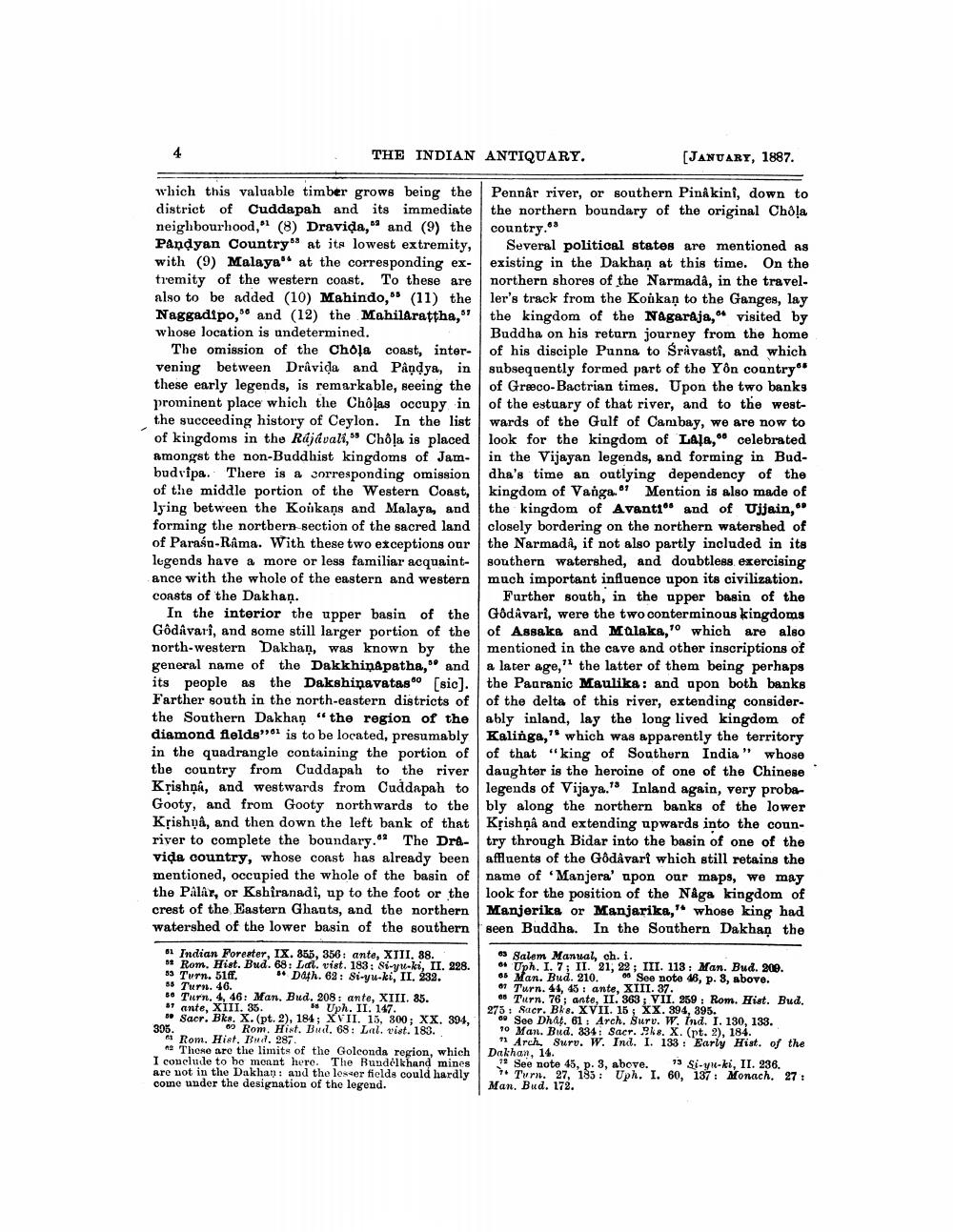________________
THE INDIAN ANTIQUARY.
[JANUARY, 1887.
which this valuable timber grows being the Pennar river, or southern Pink kini, down to district of Cuddapah and its immediate the northern boundary of the original Chola neighbourhood," (8) Dravida, and (9) the country.es Pandyan Country" at its lowest extremity, Several political states are mentioned as with (9) Malaya" at the corresponding ex- existing in the Dakhan at this time. On the tremity of the western coast. To these are northern shores of the Narmada, in the travel. also to be added (10) Mahindo,** (11) the ler's track from the Konkan to the Ganges, lay Naggadipo," and (12) the MahilArattha, the kingdom of the Nagaraja,“ visited by whose location is undetermined.
Buddha on his return journey from the home The omission of the Chola coast, inter- of his disciple Punna to Srivastî, and which vening between Drávida and Pandya, in subsequently formed part of the Yôn country" these early legends, is remarkable, seeing the of Græco-Bactrian times. Upon the two banks prominent place which the Chôļas occupy in of the estuary of that river, and to the westthe succeeding history of Ceylon. In the list wards of the Gulf of Cambay, we are now to of kingdoms in the Rájávali," Chôla is placed look for the kingdom of LALA," celebrated amongst the non-Buddhist kingdoms of Jam. in the Vijayan legends, and forming in Budbudripa. There is a corresponding omission dha's time an outlying dependency of the of the middle portion of the Western Coast, kingdom of Vanga. Mention is also made of lying between the Koikans and Malaya, and the kingdom of Avanti" and of Ujjain," forming the nortbern section of the sacred land closely bordering on the northern watershed of of Paraśn-Rama. With these two exceptions our the Narmada, if not also partly included in its legends have a more or less familiar acquaint- southern watershed, and doubtless exercising ance with the whole of the eastern and western much important influence upon its civilization. coasts of the Dakhan.
Further south, in the upper basin of the In the interior the upper basin of the Godavari, were the two conterminous kingdoms Godavari, and some still larger portion of the of Assaka and Malaka," which are also north-western Dakhan, was known by the mentioned in the cave and other inscriptions of general name of the Dakkhiņ&patha," and a later age, the latter of them being perhaps its people as the Dakshinavatas" (sic). the Paaranic Maulika: and apon both banks Farther south in the north-eastern districts of of the delta of this river, extending consider. the Southern Dakhan "the region of the ably inland, lay the long lived kingdom of diamond fields" is to be located, presumably Kalinga," which was apparently the territory in the quadrangle containing the portion of of that "king of Southern India” whose the country from Cuddapah to the river daughter is the heroine of one of the Chinese Krishņa, and westwards from Cuddapah to legends of Vijaya." Inland again, very probaGooty, and from Gooty northwards to the bly along the northern banks of the lower Krishņâ, and then down the left bank of that Krishộâ and extending upwards into the counriver to complete the boundary. The Dra. try through Bidar into the basin of one of the vide country, whose const has already been affluents of the Godavari which still retains the mentioned, occupied the whole of the basin of name of 'Manjera' upon our maps, we may the Palar, or Kshîranadi, up to the foot or the look for the position of the Någa kingdom of crest of the Eastern Ghauts, and the northern Manjerika or Manjarika," whose king had watershed of the lower basin of the southern seen Buddha. In the Southern Dakhan the
61 Indian Forester, IX. 855, 356: ante, XIII. 88. 18 Rom. Hist. Bud. 68: Lal. vist. 183: Siyu-ki, II. 228. 33 Turn. 51ff.
Daf. 62: Si-yu-ki, II. 232. 88 Turn. 46. 50 Turn. 4, 46: Man. Bud. 208: ante, XIII. 35. 87 ante, XIII. 35.
Uph. II. 147. * Sacr. Bks. X. (pt. 2), 184; XVII. 15, 300; XX. 394,
9 Rom. Hint. Bud 68: Lil vist. 183. Rom. Hist. Bul. 287 12 These are the limits of the Goleonda region, which I conclude to be mennt here. The Bundelkhand mines are not in the Dakhan and the lesser fields could hardly come under the designation of the legend.
390
Salem Manual, ch. i. - Uph. I. 7; II. 21, 22, III. 113: Man. Bud. 209. 65 Man. Bud. 210. See note 16, p. 3, above.
Turn. 44, 45 : ante, XIII. 37.
Turn. 76; ante, II. 363 ; VII. 259Rom. Hist. Bud. 275: Sacr. Bk. XVII. 15; XX. 394, 395.
" See Dha. 61 : Arch. Suru. W. Ind. I. 130, 133. 10 Man. Bud. 334: Sacr. 9. X. (pt. 2), 184.
11 Arch Surv. W. Ind. I. 133 : Early Hist. of the Dakhax, 14. * See note 45, p. 3, above. 73 Si-yu-ki, II. 236.
* Turn. 27, 185 : Uph. I. 60, 137: Monach. 27 : Man. Bud. 172.




